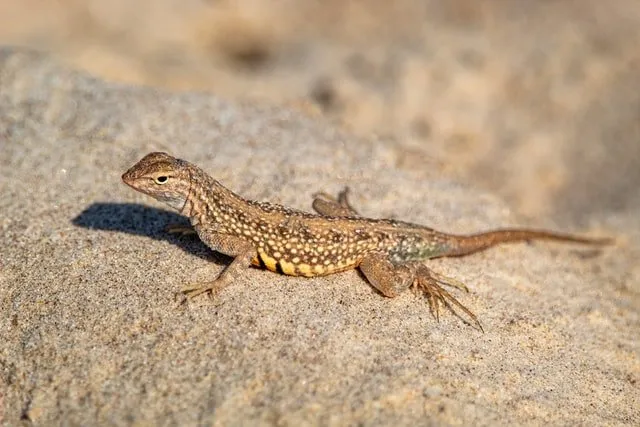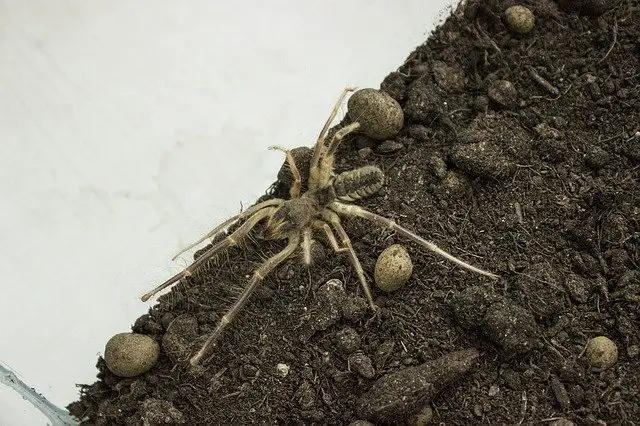As an Amazon Associate I earn from qualifying purchases.
Camel spiders are arachnids, not insects. They are found in North Africa and the Middle East. Camel spiders are not dangerous to humans, although their large size and fast movements can be unsettling. Camel spiders feed on insects and other small animals. The camel spider got its name because it is often found near camels. Camel spiders are also known as wind scorpions and sun spiders. So, what do camel spiders eat? I will discuss it more.
Camel spiders are brown or tan. They have eight legs and two long, curved jaws. Camel spiders can grow up to six inches (15 centimeters) long. Camel spiders are not venomous, but their bite can be painful. Camel spiders are shy and will usually run away if disturbed. If they feel threatened, camel spiders may chirp and raise their front legs.
Camel spiders are found in hot, dry areas such as deserts. They spend the day hiding in caves or under rocks. At night, camel spiders come out to hunt for food. Camel spiders are not considered to be true spiders. They are more closely related to mites and ticks.
What Do Camel Spiders Eat?
Camel spiders, also known as wind scorpions or solifuges, are not technically spiders. They are arachnid family members and are more closely related to mites and ticks. These strange creatures are native to deserts worldwide and can be found in places like Africa, the Middle East, and the southwestern United States.
Camel spiders are opportunistic predators and eat just about anything they can catch. Their diet includes insects, lizards, rodents, and even small birds. In addition to their large jaws, camel spiders have long, sharp fangs to inject their prey with venom. This venom is not generally harmful to humans but can cause pain and swelling at the bite site. Here are some foods that camel spiders typically eat:
1.Insects:
Camel spiders are known to eat a variety of insects. They are opportunistic feeders and will eat anything they can catch, including cockroaches, crickets, grasshoppers, and even other Camel spiders. Camel spiders generally hunt at night, using their long legs to creep through the desert sands in search of prey. When they spot an insect, they will pounce on it, using their powerful jaws to inject venom and subdue their victim.
Camel spiders will then feast on their prey, sucking out the insides and leaving behind a hollow shell. Though they are not considered dangerous to humans, Camel spiders can be a nuisance if they find their way into homes or gardens in search of food. For this reason, keeping them out of reach is best by sealing up any cracks or crevices that might give them access.
2.Lizards:
Camel spiders are known to eat a variety of lizards. Some people believe that they only eat lizards that are small in size, but this is not the case. Camel spiders will eat any size lizard they can find. Camel spiders eat so many lizards because they live in arid and semi-arid regions where there are not many other food options.
If a Camel spider can not find any food, it will not hesitate to eat one of its kind. Camel spiders are known to be aggressive and fight to the death if necessary.
3.Rodents:
Camel spiders are known to eat a variety of rodents, such as mice and rats. Camel spiders will burrow into the sand to wait for their prey. Once the prey is within range, the camel spider will launch and grab it with its powerful legs. Camel spiders will then paralyze their prey with their venom before devouring it. Camel spiders typically live in deserts but can also be found in other hot, dry environments. Camel spiders are not venomous to humans and are not dangerous unless provoked. Camel spiders can consume an entire rodent in a matter of minutes.
4.Birds:
Camel spiders are known to eat a variety of rodents. They have been known to eat anything they can get their hands on, including lizards, snakes, birds, and even small mammals. Camel spiders are opportunistic feeders, meaning they will take advantage of any food source they can find. This is one of the reasons why camel spiders are often found around human settlements; there is always a plentiful supply of food.
5.Rabbits:
Rabbits are one of their favorite prey items. Camel spiders will stalk a rabbit until it is within striking distance, then pounce on the unsuspecting animal and inject it with venom. The venom quickly paralyzes the rabbit and allows the camel spider to devour its prey alive. Camel spiders typically only eat the soft tissues of their prey, such as the muscles and organs. The hard parts of the animal, such as the skeleton and fur, are usually left behind.
6.Snakes:
Camel spiders are easily recognizable by their large size and distinctive shape. They are also known for their predatory habits, and one of their favorite snacks is the snake. Camel spiders typically stalk their prey before pouncing, and they have been known to eat various snake species. While camel spiders generally prefer small snakes, they have occasionally taken down larger prey. Camel spiders have been known to kill and eat rabbits, lizards, and even scorpions. So, if you’re ever unlucky enough to come across a camel spider, it’s best to give it a wide berth.
How Do Camel Spiders Hunt?
Camel spiders aresolifuges, meaning they cannot structurally produce venom like most arachnids. Instead, they hunt and subdue their prey through physical activity, relying on their size and strength to overwhelm smaller creatures. When Camel spiders detect their prey, they will first stalk the victim until it is within range. Once within range, the Camel spider will pounce on the unfortunate creature, using its powerful legs to deliver a crushing blow.
This initial strike is often enough to kill or immobilize smaller prey items. For larger victims, the Camel spider will sink its teeth into the flesh of its victim and then proceed to wrap the unfortunate creature in webbing. Once wrapped up, the Camel spider will finish its meal by sucking out all bodily fluids. This gruesome feeding method ensures that nothing goes to waste and that the Camel spider can make a quick getaway if necessary.
While Camel spiders typically hunt alone, they are not above working together to take down larger prey items. Cooperative hunting behavior has been observed in both captive and wild populations of Camel spiders, suggesting that this behavior is innate rather than learned. Regardless of how they hunt, Camel spiders are fierce predators that seriously threaten any creature unlucky enough to cross their path.
What Eats Camel Spiders?
Most people would be surprised to learn that the answer is not always simple. While it is true that Camel spiders do have many predators, they are also scavengers and will often eat almost anything they come across.
This includes other Camel spiders, lizards, snakes, rodents, and even larger animals such as birds and small mammals. Their ability to eat such a wide variety of foods is one of the things that makes them such successful hunters. What sets them apart from other predators, however, is their size.
Camel spiders can grow up to 10 inches long, making them one of the largest spiders in the world. Their size, speed, and agility make them a force to be reckoned with in the animal kingdom.
Wrapping Up
Camel spiders are found in hot, dry areas such as deserts. They spend the day hiding in caves or under rocks. At night, camel spiders come out to hunt for food. Their diet consists mostly of insects and small animals, but they will also occasionally eat larger prey. Camel spiders are not venomous to humans, but their bites can be painful. If you come across a camel spider, it’s best to leave it alone.
You can also read:
WHAT DO JORO SPIDERS EAT? A COMPLETE GUIDE
WHAT DO WOLF SPIDERS EAT? 8 FAVORITE FOODS
WHAT DO SPIDERS EAT? 7 COMMON FOODS
WHAT DO BABY SEAGULLS EAT? A COMPLETE GUIDE
Amazon and the Amazon logo are trademarks of Amazon.com, Inc, or its affiliates.



